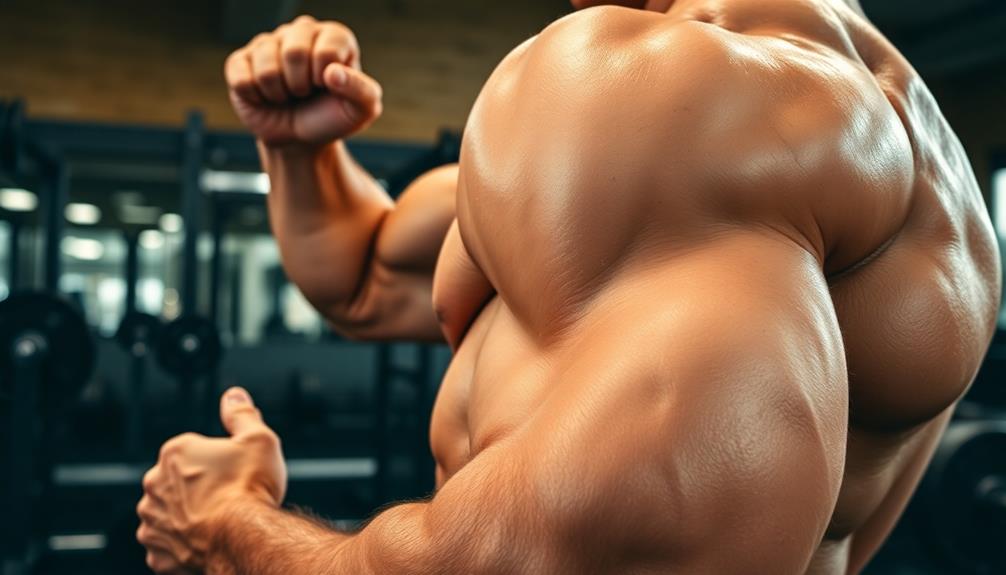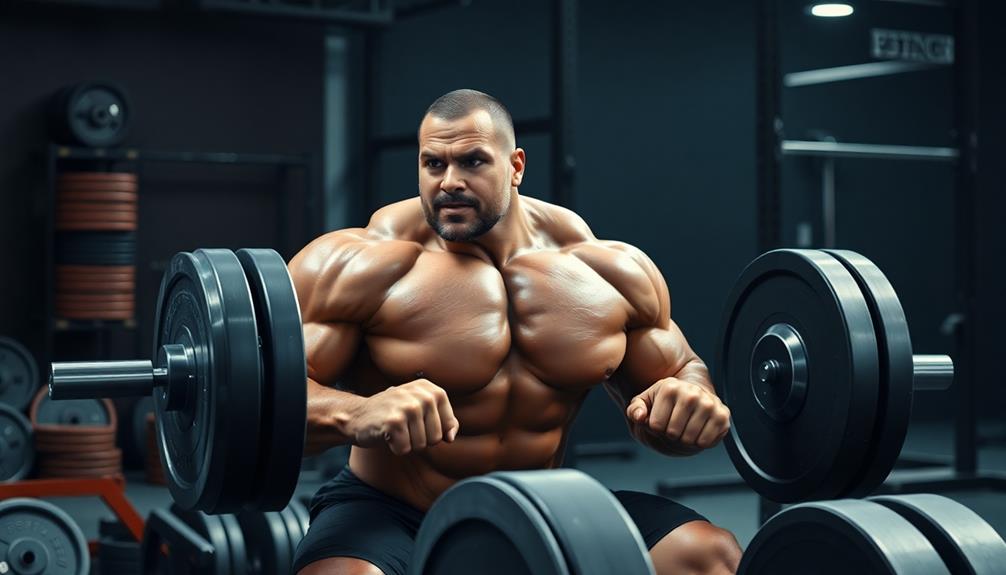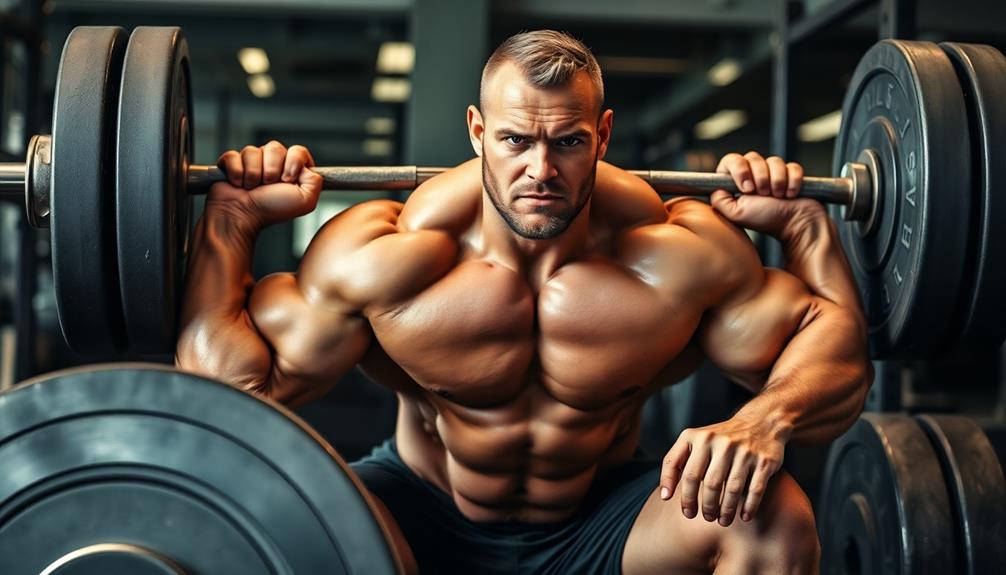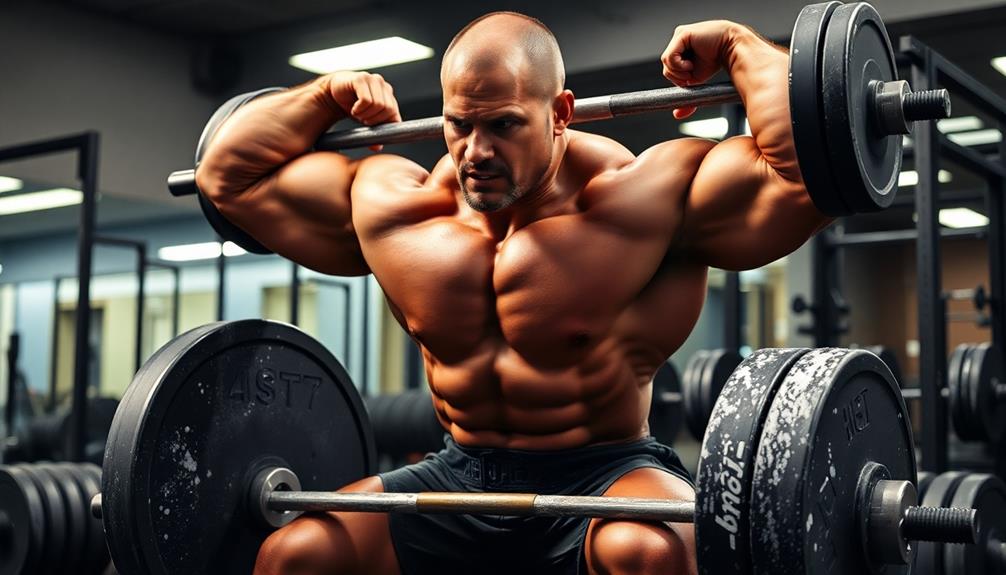To build muscle with hypertrophy programs as a powerlifter, you'll need to balance strength and size goals. Focus on compound movements like squat, bench press, and deadlift variations, working each muscle group 2-3 times a week. Start with 10-20 sets per muscle group weekly and gradually increase volume over time. Implement progressive overload by increasing weight, reps, sets, or speed. Proper nutrition and rest are essential for muscle growth and recovery. Track your progress and adjust your training as needed. By incorporating these principles, you'll optimize your muscle-building potential while maintaining your powerlifting focus. Let's explore how to fine-tune your approach for maximum results.
Core Insight
- Focus on compound movements like squats, bench presses, and deadlifts for maximum muscle growth.
- Aim for 10-20 sets per muscle group weekly, gradually increasing volume over time.
- Implement progressive overload by increasing weight, reps, or sets to continually challenge muscles.
- Balance hypertrophy training with strength-focused sessions to meet powerlifting goals.
- Ensure adequate protein intake and rest for optimal muscle recovery and growth.
Understanding Hypertrophy for Powerlifters

Powerlifters need to understand hypertrophy to make long-term progress. Hypertrophy means increasing muscle size, which helps you get stronger overall. Adding hypertrophy training to your powerlifting routine is beneficial. Protein powders can help with muscle growth and recovery when used with the right training and nutrition plan.
Hypertrophy happens when resistance training causes small tears in your muscle fibers. Your body fixes these tears, making your muscles bigger and stronger. To get the most hypertrophy, focus on:
- Doing more sets and reps than you would for strength training
- Slowing down your reps to put more stress on your muscles
- Using different exercises to work muscles from various angles
- Gradually increasing weight or reps over time
Balancing Strength and Size Goals

Powerlifters often struggle to balance strength and size goals. While strength is key in powerlifting, muscle size can also help overall performance. To balance these goals, try these tips:
- Switch between strength and muscle-building training cycles
- Add exercises to build muscle in areas that help your main lifts
- Change your reps and weights to work on both strength and size
If you want to build more muscle, muscle gainer supplements can help support your diet plan. They give you the nutrients you need to build muscle and recover.
Strength and size aren't opposites. With a good program that works on both, you can build a strong and muscular physique. Don't forget about proper diet and rest, as these are also important for reaching your strength and size goals. Keep track of your progress and make changes as needed to keep moving towards your goals.
Optimal Training Frequency and Volume

To build muscle while maintaining strength as a powerlifter, you need to find the right balance of training frequency and volume. Aim to work each muscle group 2-3 times a week. This gives your muscles enough stimulus to grow and recover. Start with 10-20 sets per muscle group each week and adjust as needed.
Over time, gradually increase your training volume by adding sets, reps, or weight. But don't push yourself too hard or too fast. Listen to your body and make changes when necessary. Rest and good nutrition are just as important as training for reaching your muscle growth goals and keeping your strength.
Exercise Selection for Muscle Growth

When choosing exercises to build muscle, focus on compound movements that work multiple muscle groups at once. These exercises stimulate the most muscle fibers, helping you gain size and strength. You can also include supplements like nitric oxide boosters to increase blood flow and enhance your muscle pumps during training.
The best exercises for muscle growth are:
- Squat, bench press, and deadlift variations
- Accessory exercises like rows, pull-ups, and leg presses that target specific muscles
- Isolation exercises to strengthen weak points and improve muscle definition
Switch up your exercises every so often to avoid plateaus and keep making progress. Consider your individual strengths and weaknesses when picking exercises. The most important thing is to choose movements that let you gradually increase the weight while using proper form.
Progressive Overload in Hypertrophy Training

Progressive overload is the key to any muscle-building program that works. It means slowly adding more stress to your muscles as you go. To do this, you'll need to change things like weight, reps, sets, or speed.
Write down your lifts every time. Try to add a little more weight each week, even if it's small. If you can't lift heavier, do more reps or sets. You can also slow down the lowering part of your lifts to make your muscles work longer.
Focus on these natural methods for safe, lasting results. They'll help you get stronger over time without risking your health.
Nutrition for Muscle Building

Eating right is just as important as working out when it comes to building muscle. You need to eat enough calories and protein to help your muscles grow. Aim to eat 300-500 more calories than you burn each day. You should also eat 1.6-2.2 grams of protein for every kilogram of your body weight.
Carbs after your workout are key for recovery and muscle growth. Think about adding a good carb powder to your diet plan.
To make the most of your muscle-building diet, keep these things in mind:
- Choose whole foods that are packed with nutrients
- Eat protein throughout the day, not just all at once
- Eat carbs to power your workouts and help you recover
Don't forget about vitamins and minerals. They're important for muscle growth and overall health. Eat plenty of fruits, veggies, and whole grains. Drink lots of water to stay hydrated. Stick to your nutrition plan over the long term to see the best muscle gains.
Recovery and Injury Prevention

Recovery and injury prevention are key for powerlifters looking to build muscle. Make sure to get enough sleep, about 7-9 hours each night. On days off from lifting, do light cardio or mobility exercises to help your muscles recover. Using cold therapy compression wraps can also reduce soreness and inflammation after tough workouts.
Always warm up before lifting and cool down after. Stretching and foam rolling help keep your muscles flexible and prevent tightness. Getting regular massages is another way to recover better and avoid injuries.
Frequently Asked Questions
How Long Does It Take to See Noticeable Muscle Gains From Hypertrophy Training?
You'll typically start seeing noticeable muscle gains from hypertrophy training within 4-8 weeks. However, results vary based on factors like genetics, diet, and consistency. Keep at it, and you'll see more significant changes over time.
Can Powerlifters Benefit From Bodybuilding-Style Isolation Exercises in Their Hypertrophy Programs?
Yes, you'll benefit from bodybuilding-style isolation exercises in your hypertrophy program. They'll help you target specific muscles, improve weaknesses, and increase overall muscle mass. You'll see better symmetry and enhanced performance in your powerlifting moves.
What's the Ideal Rep Range for Hypertrophy When Working With Near-Maximal Loads?
For hypertrophy with near-maximal loads, you'll want to aim for 6-8 reps per set. This range allows you to maintain heavy weight while still accumulating enough volume to stimulate muscle growth effectively.
How Do Hormones Like Testosterone and Growth Hormone Affect Muscle Hypertrophy?
Testosterone and growth hormone greatly boost your muscle hypertrophy. They increase protein synthesis, enhance muscle recovery, and promote fat loss. You'll experience greater muscle growth and strength gains when these hormones are optimized through training and nutrition.
Are There Any Supplements Specifically Beneficial for Powerlifters Pursuing Hypertrophy Goals?
You'll find several supplements beneficial for hypertrophy goals. Creatine monohydrate, whey protein, and beta-alanine can support muscle growth. Citrulline malate may improve workout performance. Remember, supplements work best alongside a proper diet and training program.

